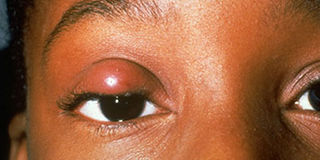Keep your hands clean to fight styes

Most styes do not need treatment and go away within a week.
What you need to know:
- It is itchy and sometimes painful and will definitely interfere with your looks. However, it is quite common to suffer from a stye at least once. But, there is nothing to worry about as this eye ailment can be easily treated.
A stye locally known as akasekele is also sometimes called hordeolum. Dr George Edward Kakungulu, a general physician, says a stye is caused by staphylococcal bacteria which is found in the nose and is transferred easily to the eye when you rub your nose, then your eye.
When the bacteria are transferred to the eye, they can cause infection of the eyelash follicle, oil glands that drain through ducts into the eyelashes. “As a result of blockage in the flow of lymphatic fluid, the fluid is retained into the gland. This is a very small gland located inside the eyelid and its function is to provide oil for keeping the eye lubricated. The gland becomes swollen and inflamed, causing the stye,” Dr Kakungulu explains.
Treatment
According to Dr Moses Semulya, an optician, most styes do not need treatment and go away within a week. He recommends managing the pain by applying hot or cold compresses for 10 to 15 minutes, three or four times a day, over the course of several days. He cautions against trying to pop the stye and says it should be left to open on its own a process that can be speeded up by hot compresses. However, he says, although most styes will go away with warm compresses, some known as internal hordeolum need to be treated medically or drained surgically.
Also, if you have frequent styes, your eye doctor may want to prescribe an antibiotic ointment to prevent recurrence. “Reoccurring styes may indicate that your eyelids need to be cleaned more often. Doctors usually recommend using a small amount of baby shampoo on a cotton swab or washcloth to clean your eyelids. Regularly washing away skin dwelling bacteria from the eyelid will decrease the risk of eyelash follicles becoming infected,” says Dr Semulya.
Prevention
Dr Raymon Baluku, a general physician, notes that certain habits such as touching your eyes without washing them, not disinfecting your contact lenses, and using old cosmetics put you at risk of developing styes.
“If you have a stye, observe personal hygiene to prevent it from spreading to other people. To avoid spreading stye-causing bacteria, keep your eyes and hands clean and do not share pillowcases, bedsheets, washcloths or towels with others,” he advises. Keep your nails clean and short so that they do not habour bacteria that can infect the eyes when you scratch your eyelids.
Some people confuse styes for another type of bump on the eye called a chalazion. Unlike styes, chalazions are mostly painless. Chalazions appear as small bumps in the eyelid that are caused by blocked oil glands. Similar to styes, chalazions can usually be treated with a warm compress. If left without treatment, some styes eventually turn into chalazions.
The bacteria from one stye can sometimes spread and cause additional styes. When an individual has multiple styes or their entire eyelid is infected, or if you notice that irritation and swelling has moved beyond your eye and spread to other areas of your face, such as your cheek, it is best to visit a health care professional for further management.
Home remedies
Tea bag
You will need a tea bag and warm water. Dip the tea bag in warm water for a minute. Remove the extra water and place this tea bag on the affected eye until the bag cools down. If the stye is on the inside of the lid, place the bag over the lid. You can also use a used tea bag for this. Repeat this two to three times in the day.
Why this works
Warm tea bags not only give relief from the pain but also helps reduce the swelling within 48 hours.
Water and salt
You will need one litre of water, two teaspoons of salt and a soft cloth or face towel. Boil the water and add the salt into it. Let the water cool a little, and then dip a towel or soft cloth in it. Compress the affected area with the water and leave it there for 20 minutes until the towel is no longer warm. Do this twice a day until the stye is healed.
Why this works
The warmth of the water will soothe the irritating eye stye. It will reduce the pain and also the swelling by promoting circulation. Salt in this remedy acts as an antimicrobial agent.
Source: stylecraze.com




